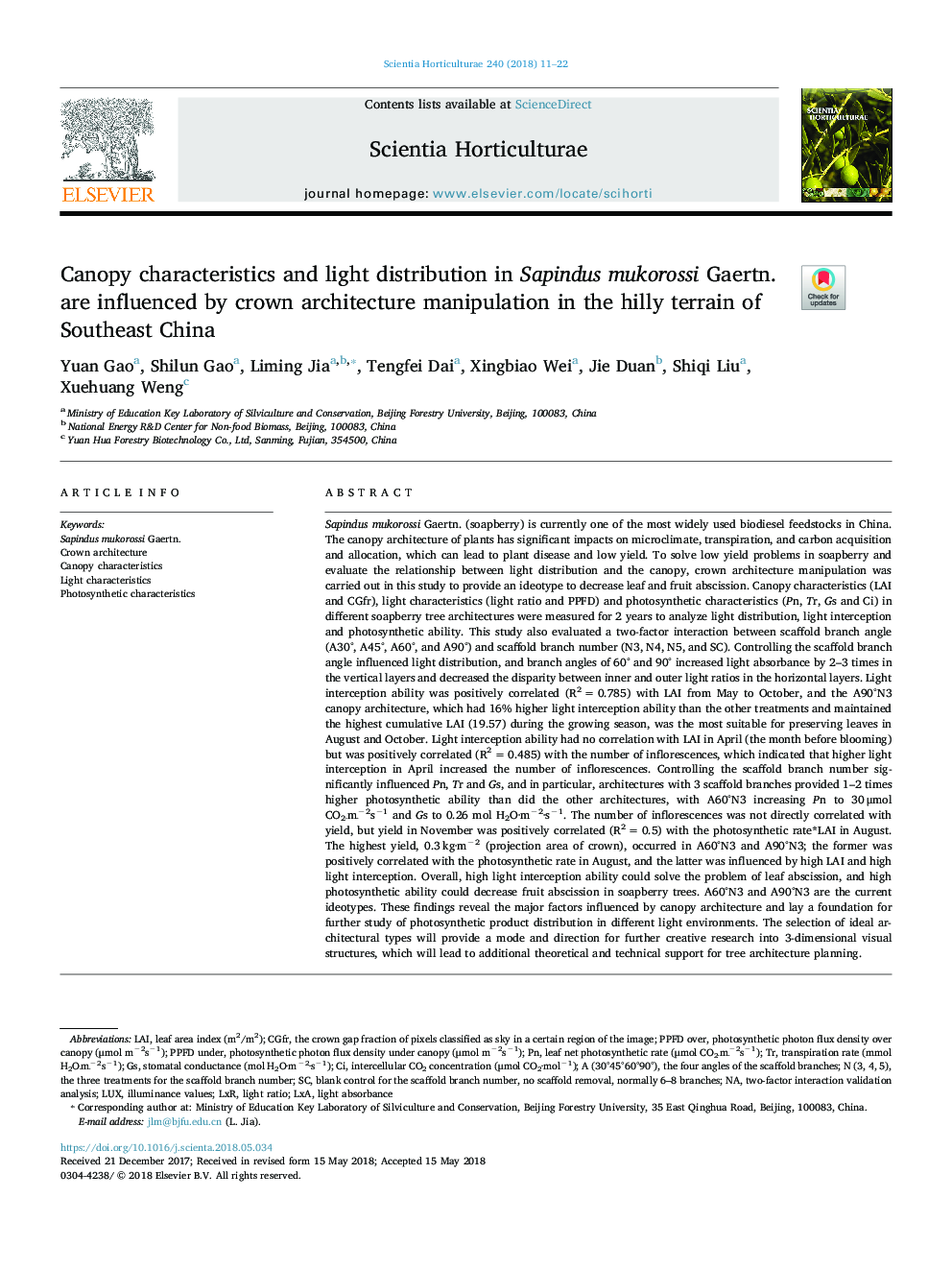| کد مقاله | کد نشریه | سال انتشار | مقاله انگلیسی | نسخه تمام متن |
|---|---|---|---|---|
| 8892360 | 1628758 | 2018 | 12 صفحه PDF | دانلود رایگان |
عنوان انگلیسی مقاله ISI
Canopy characteristics and light distribution in Sapindus mukorossi Gaertn. are influenced by crown architecture manipulation in the hilly terrain of Southeast China
دانلود مقاله + سفارش ترجمه
دانلود مقاله ISI انگلیسی
رایگان برای ایرانیان
کلمات کلیدی
موضوعات مرتبط
علوم زیستی و بیوفناوری
علوم کشاورزی و بیولوژیک
دانش باغداری
پیش نمایش صفحه اول مقاله

چکیده انگلیسی
Sapindus mukorossi Gaertn. (soapberry) is currently one of the most widely used biodiesel feedstocks in China. The canopy architecture of plants has significant impacts on microclimate, transpiration, and carbon acquisition and allocation, which can lead to plant disease and low yield. To solve low yield problems in soapberry and evaluate the relationship between light distribution and the canopy, crown architecture manipulation was carried out in this study to provide an ideotype to decrease leaf and fruit abscission. Canopy characteristics (LAI and CGfr), light characteristics (light ratio and PPFD) and photosynthetic characteristics (Pn, Tr, Gs and Ci) in different soapberry tree architectures were measured for 2 years to analyze light distribution, light interception and photosynthetic ability. This study also evaluated a two-factor interaction between scaffold branch angle (A30°, A45°, A60°, and A90°) and scaffold branch number (N3, N4, N5, and SC). Controlling the scaffold branch angle influenced light distribution, and branch angles of 60° and 90° increased light absorbance by 2-3 times in the vertical layers and decreased the disparity between inner and outer light ratios in the horizontal layers. Light interception ability was positively correlated (R2â¯=â¯0.785) with LAI from May to October, and the A90°N3 canopy architecture, which had 16% higher light interception ability than the other treatments and maintained the highest cumulative LAI (19.57) during the growing season, was the most suitable for preserving leaves in August and October. Light interception ability had no correlation with LAI in April (the month before blooming) but was positively correlated (R2â¯=â¯0.485) with the number of inflorescences, which indicated that higher light interception in April increased the number of inflorescences. Controlling the scaffold branch number significantly influenced Pn, Tr and Gs, and in particular, architectures with 3 scaffold branches provided 1-2 times higher photosynthetic ability than did the other architectures, with A60°N3 increasing Pn to 30â¯Î¼mol CO2·mâ2·sâ1 and Gs to 0.26 mol H2O·mâ2·sâ1. The number of inflorescences was not directly correlated with yield, but yield in November was positively correlated (R2â¯=â¯0.5) with the photosynthetic rate*LAI in August. The highest yield, 0.3â¯kg·mâ2 (projection area of crown), occurred in A60°N3 and A90°N3; the former was positively correlated with the photosynthetic rate in August, and the latter was influenced by high LAI and high light interception. Overall, high light interception ability could solve the problem of leaf abscission, and high photosynthetic ability could decrease fruit abscission in soapberry trees. A60°N3 and A90°N3 are the current ideotypes. These findings reveal the major factors influenced by canopy architecture and lay a foundation for further study of photosynthetic product distribution in different light environments. The selection of ideal architectural types will provide a mode and direction for further creative research into 3-dimensional visual structures, which will lead to additional theoretical and technical support for tree architecture planning.
ناشر
Database: Elsevier - ScienceDirect (ساینس دایرکت)
Journal: Scientia Horticulturae - Volume 240, 20 October 2018, Pages 11-22
Journal: Scientia Horticulturae - Volume 240, 20 October 2018, Pages 11-22
نویسندگان
Yuan Gao, Shilun Gao, Liming Jia, Tengfei Dai, Xingbiao Wei, Jie Duan, Shiqi Liu, Xuehuang Weng,